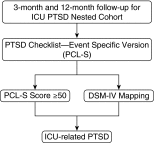Incidence and Risk Factors for Intensive Care Unit-related Post-traumatic Stress Disorder in Veterans and Civilians
- PMID: 26735627
- PMCID: PMC4910886
- DOI: 10.1164/rccm.201506-1158OC
Incidence and Risk Factors for Intensive Care Unit-related Post-traumatic Stress Disorder in Veterans and Civilians
Abstract
Rationale: The incidence and risk factors of post-traumatic stress disorder (PTSD) related to the intensive care unit (ICU) experience have not been reported in a mixed veteran and civilian cohort.
Objectives: To describe the incidence and risk factors for ICU-related PTSD in veterans and civilians.
Methods: This is a prospective, observational, multicenter cohort enrolling adult survivors of critical illness after respiratory failure and/or shock from three Veterans Affairs and one civilian hospital. After classifying those with/without preexisting PTSD (i.e., PTSD before hospitalization), we then assessed all subjects for ICU-related PTSD at 3 and 12 months post hospitalization.
Measurements and main results: Of 255 survivors, 181 and 160 subjects were assessed for ICU-related PTSD at 3- and 12-month follow-up, respectively. A high probability of ICU-related PTSD was found in up to 10% of patients at either follow-up time point, whether assessed by PTSD Checklist Event-Specific Version (score ≥ 50) or item mapping using the Diagnostic and Statistical Manual of Mental Disorders-IV (DSM-IV). In the multivariable regression, preexisting PTSD was independently associated with ICU-related PTSD at both 3 and 12 months (P < 0.001), as was preexisting depression (P < 0.03), but veteran status was not a consistent independent risk factor for ICU-related PTSD (3-month P = 0.01, 12-month P = 0.48).
Conclusions: This study found around 1 in 10 ICU survivors experienced ICU-related PTSD (i.e., PTSD anchored to their critical illness) in the year after hospitalization. Preexisting PTSD and depression were strongly associated with ICU-related PTSD.
Keywords: intensive care unit; post-traumatic stress disorder; veterans.
Figures



Comment in
-
Critical Illness-related Post-traumatic Stress. An Important Message.Am J Respir Crit Care Med. 2016 Jun 15;193(12):1326-7. doi: 10.1164/rccm.201601-0095ED. Am J Respir Crit Care Med. 2016. PMID: 27304237 No abstract available.
References
-
- Stevens RD, Sharshar T, Ely EW. Brain disorders in critical illness. New York: Cambridge University Press; 2013.
-
- Peitz GJ, Balas MC, Olsen KM, Pun BT, Ely EW. Top 10 myths regarding sedation and delirium in the ICU. Crit Care Med. 2013;41:S46–S56. - PubMed
-
- Wade DM, Brewin CR, Howell DCJ, White E, Mythen MG, Weinman JA. Intrusive memories of hallucinations and delusions in traumatized intensive care patients: an interview study. Br J Health Psychol. 2015;20:613–631. - PubMed
-
- Jones C, Bäckman C, Capuzzo M, Flaatten H, Rylander C, Griffiths RD. Precipitants of post-traumatic stress disorder following intensive care: a hypothesis generating study of diversity in care. Intensive Care Med. 2007;33:978–985. - PubMed
Publication types
MeSH terms
Grants and funding
LinkOut - more resources
Full Text Sources
Other Literature Sources
Medical

